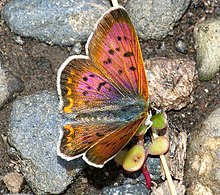
Lycaenidae is the second-largest family of butterflies, with over 6,000 species worldwide, whose members are also called gossamer-winged butterflies. They constitute about 30% of the known butterfly species.

Lycaena phlaeas, the small copper, American copper, or common copper, is a butterfly of the Lycaenids or gossamer-winged butterfly family. According to Guppy and Shepard (2001), its specific name phlaeas is said to be derived either from the Greek φλέγω (phlégo), "to burn up", or from the Latin floreo, "to flourish".

The purple-edged copper is a butterfly of the family Lycaenidae.

Lycaena epixanthe, also known as the bog copper or cranberry-bog copper, is a North American species of butterfly in the family Lycaenidae. Adults like to sip drops of dew clinging to leaves and almost exclusively nectar on their host plant, cranberries. Because of this, bog coppers will spend their entire lives within the area of a single acid bog. Even though their flight is weak and close to the ground, bog coppers are hard to catch because of the habitat in which they live. Also, 85% of the bog coppers life span is spent in the egg. It is listed as a species of special concern in the US state of Connecticut.
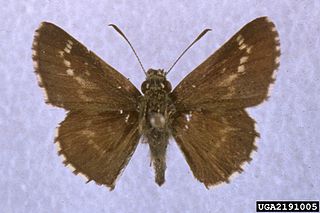
Amblyscirtes aesculapius is a butterfly of the family Hesperiidae. It is found from eastern Oklahoma and eastern Texas, east to south-east Virginia, south along the Atlantic Coast to northern Florida.

Amblyscirtes vialis is a butterfly of the family Hesperiidae. It is found from British Columbia east across southern Canada to Maine and Nova Scotia, south to central California, northern New Mexico, Texas, the Gulf states and northern Florida.
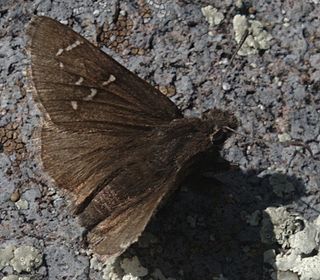
Thorybes mexicana, the Mexican cloudywing, mountain cloudy wing or Nevada cloudy wing, is a butterfly of the family Hesperiidae. It is found in the high elevation mountains of the western United States south into Mexico.

Lycaena hyllus, the bronze copper, is a butterfly of the lycaenids family found in North America.
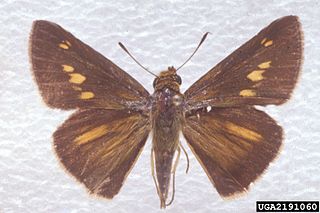
Euphyes dion, the Dion skipper or Alabama skipper, is a species of butterfly of the family Hesperiidae. It is found in scattered populations along the Atlantic coast of North America, from western Massachusetts and south-eastern New York south to north-eastern Florida, west to north-eastern Texas, and north to south-eastern North Dakota, northern Wisconsin, southern Ontario and southern Quebec. It is listed as a species of special concern in the US state of Connecticut.

Chlosyne whitneyi, the rockslide checkerspot or Sierra Nevada checkerspot, is a butterfly of the family Nymphalidae. It is found in western North America from British Columbia and Alberta south, in the mountains, to California and Colorado.
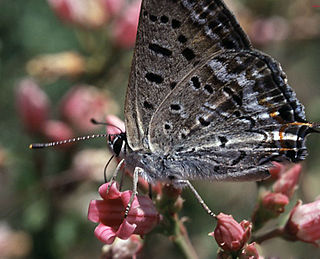
Lycaena arota, the tailed copper, is a butterfly of the family Lycaenidae. It is found in North America from New Mexico north and west to Oregon, south to southern California and Baja California, Mexico.
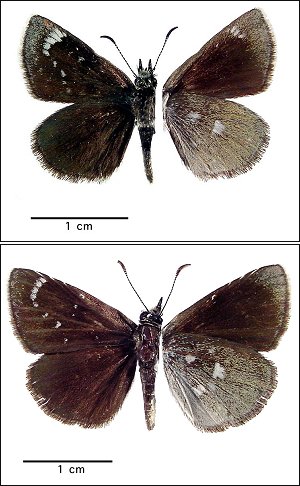
Hesperopsis libya, the Mojave sootywing, Mohave sootywing, Great Basin sootywing or Lena sooty wing, is a butterfly of the family Hesperiidae. It is found in North America from eastern Oregon east to Montana and south to southern California, Arizona, and north-western Mexico including Baja California. Its habitats include alkalai flats, sagebrush desert, desert hills, shale barrens, watercourses, and ravines.

Lycaena cuprea, the lustrous copper, is a butterfly of the family Lycaenidae. It is found in the western mountains of North America.

Lycaena rubidus, the ruddy copper, is a butterfly of the family Lycaenidae. It is found in the western mountains of North America. Adults lay their eggs on plants of the genus Rumex, which later become the larval food plants. This butterfly gets its name from the brightly colored wings of the males, which are important in sexual selection. Its larvae exhibit mutualism with red ants, and are often raised in ant nests until they reach adulthood. Adults are on wing from mid-July to early August.
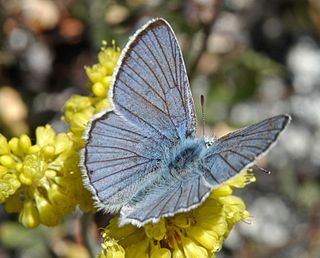
Lycaena heteronea, the blue copper, is an American butterfly that belongs to the gossamer-winged family. The butterfly is named so because of the bright blue hue of the upper side of the males' wings. Females are brown on their upper side. Both sexes are white with black spots on the underside of the wings. Blue coppers are seen on the west coast of the United States and the southwest region of Canada, particularly British Columbia and Alberta. The males are often confused with Boisduval’s blue, another species of butterfly. Blue coppers prefer to live in areas where species of Eriogonum are found. Blue copper larvae sometimes form mutualistic associations with Formica francoeuri, an ant species.
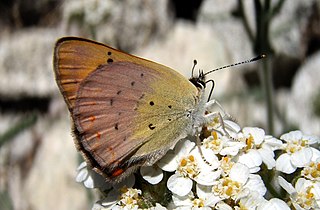
Lycaena nivalis, the lilac-bordered copper or nivalis copper, is a butterfly of the family Lycaenidae. It is found in the western mountains of North America.
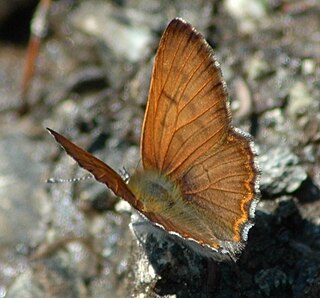
Lycaena mariposa, the mariposa copper, is a butterfly of the family Lycaenidae. It is found in western Canada and the United States.

Anthanassa texana, the Texan crescentspot, is a species of butterfly in the family Nymphalidae. It is found from Guatemala north through Mexico to southern California, east across the southern United States to northern Florida, Georgia and South Carolina. Strays may be found up to Arkansas, Missouri, Illinois, South Dakota, and central Nevada. The habitat consists of deserts, dry gulches, open areas, streamsides, road edges, and city parks.

Callophrys spinetorum, the thicket hairstreak, is a butterfly of the family Lycaenidae. It was described by William Chapman Hewitson in 1867. It is found in North America from British Columbia through the Rocky Mountains to New Mexico and Mexico and through California to Baja California. The habitat consists of pinyon-juniper forests, mixed woodlands, and coniferous forests.
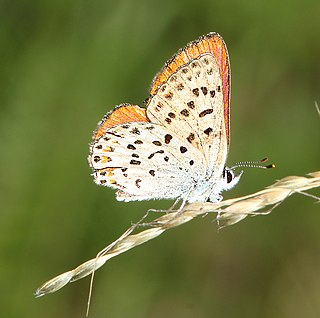
Lycaena gorgon, known generally as the gorgon copper or stream water-crowfoot, is a species of copper in the butterfly family Lycaenidae. It is found in North America, mainly in California.
